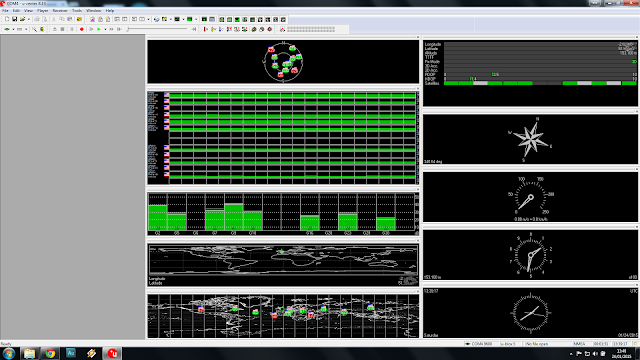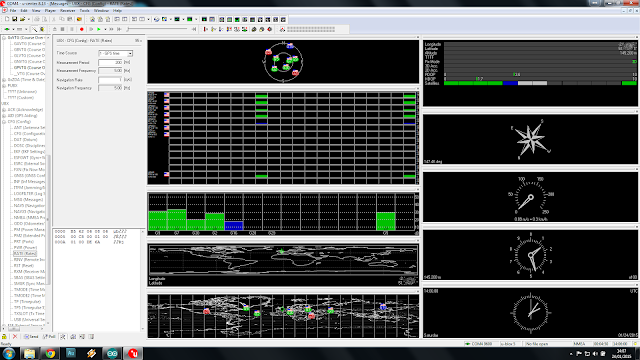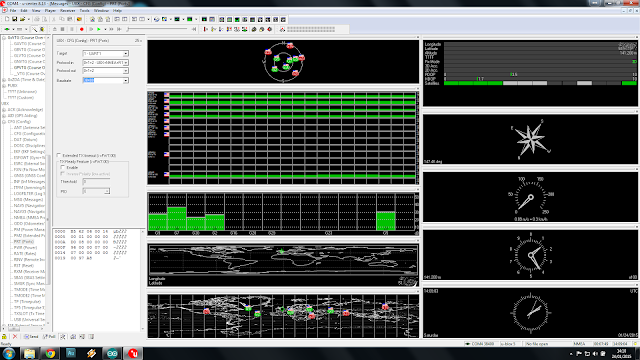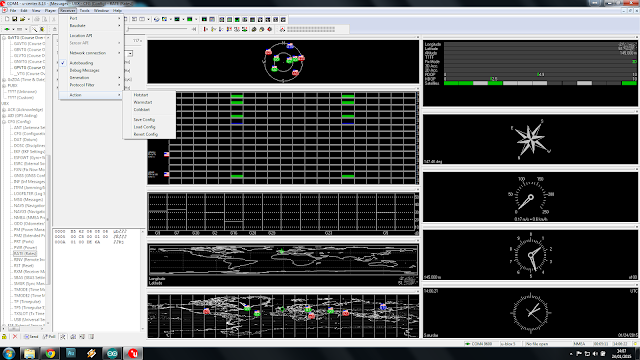It also had me thinking that when power is restored, our mode settings are lost, it resets them to "Auto", which may not be a good idea.
The solution is to store the settings in EEPROM for future use.
Now if the clock isn't set, then the time will still default to the time the sketch was complied, and the default mode is now set to off, a fail-safe condition. If the clock is still running (which it should be if your Lipo is OK), then the settings are restored from memory. Happy days.
The addition of the EEPROM library (standard fit in the newer revisions of the Arduino IDE) and the use of EEPROM.read and EEPROM.write commands provides an easy solution.
I also now check to see if, when the mode is set to ON, that it's not frozen.
Here's the new code...
// Dawn & Dusk controller with frost protection. // 5th December 2014. Modified 17th April 2015 // (C) A.G.Doswell 2014 & 2015 // // Date and time functions using a DS1307 RTC connected via I2C and Wire lib // // Designed to control a relay connected to pin A3. Pin goes low during daylight hours and high during night. Relay uses active low, so is // "On" during the day. This is connected to the fountain pump in my garden. // // Time is set using a rotary encoder with integral push button. The Encoder is connected to interrupt pins D2 & D3 (and GND), // and the push button to pin analogue 0 (and GND) // The RTC is connections are: Analogue pin 4 to SDA. Connect analogue pin 5 to SCL. // A 2 x 16 LCD display is connected as follows (NOTE. This is NOT conventional, as interrupt pins are required for the encoder) // Arduino LCD // D4 DB7 // D5 DB6 // D6 DB5 // D7 DB4 // D12 RS // D13 E // // In this revision, there is a Dallas 18B20 Temperature sensor connected to pin 8, enabling frost protection. This is pulled up to +5volts via a 4.7K resistor. // // Use: Pressing and holding the button will enter the clock set mode (on release of the button). Clock is set using the rotary encoder. // The clock must be set to UTC. // Pressing and releasing the button quickly will display the current sun rise and sun set times. Pressing the button again will enter the mode select menu. // Modes are AUTO: On when the sun rises, off when it sets. // AUTO EXTEND : same as above but goes off 1 hour after sunet (nice for summer evenings!) // ON: Permanently ON // OFF: Permanently OFF (Who'd have guessed it?) // // Change the LATTITUDE and LONGITUDE constant to your location. // Use the address finder from http://www.hacktronics.com/Tutorials/arduino-1-wire-address-finder.html to find the address of your temperature sensor and enter it where required in DeviceAddress. // 28th Dec 2014 - Slowed the rate at which the temperature is requested down to once per minute. It has improved the clock display, and solved an issue whereby the temp sensor wasn't always ready to send data, and hung up. // 10th Jan 2015 - Altered the method of updating the temp to something simpler and more sensible! // 17th April 2015 - Stored Mode settings in EEPROM // // Be sure to visit my website at http://andydoz.blogspot.com #include <Wire.h> #include "RTClib.h" // from https://github.com/adafruit/RTClib #include <LiquidCrystal.h> #include <Encoder.h> // from http://www.pjrc.com/teensy/td_libs_Encoder.html #include <TimeLord.h> // from http://swfltek.com/arduino/timelord.html. When adding it to your IDE, rename the file, removing the "-depreciated" #include <OneWire.h> // from http://playground.arduino.cc/Learning/OneWire #include <DallasTemperature.h> // from http://www.hacktronics.com/code/DallasTemperature.zip. When adding this to your IDE, ensure the .h and .cpp files are in the top directory of the library. #include <EEPROM.h> #define ONE_WIRE_BUS 8 // Data wire from temp sensor is plugged into pin 8 on the Arduino OneWire oneWire(ONE_WIRE_BUS); // Setup a oneWire instance to communicate with any OneWire devices DeviceAddress outsideThermometer = { 0x28, 0x1A, 0x1A, 0x3E, 0x06, 0x00, 0x00,0xC7 }; // use the address finder from http://www.hacktronics.com/Tutorials/arduino-1-wire-address-finder.html to find the address of your device. RTC_DS1307 RTC; // Tells the RTC library that we're using a DS1307 RTC Encoder knob(2, 3); //encoder connected to pins 2 and 3 (and ground) LiquidCrystal lcd(12, 13, 7, 6, 5, 4); // I used an odd pin combination because I need pin 2 and 3 for the interrupts. //the variables provide the holding values for the set clock routine int setyeartemp; int setmonthtemp; int setdaytemp; int sethourstemp; int setminstemp; int setsecs = 0; int maxday; // maximum number of days in the given month int TimeMins = 0; // number of seconds since midnight int TimerMode = 2; //mode 0=Off 1=On 2=Auto int TimeOut = 10; int TimeOutCounter; // These variables are for the push button routine int buttonstate = 0; //flag to see if the button has been pressed, used internal on the subroutine only int pushlengthset = 3000; // value for a long push in mS int pushlength = pushlengthset; // set default pushlength int pushstart = 0;// sets default push value for the button going low int pushstop = 0;// sets the default value for when the button goes back high int knobval; // value for the rotation of the knob boolean buttonflag = false; // default value for the button flag float tempC; // Temperature const int TIMEZONE = 0; //UTC const float LATITUDE = 51.89, LONGITUDE = -2.04; // set YOUR position here int Sunrise, Sunset; //sunrise and sunset expressed as minute of day (0-1439) TimeLord myLord; // TimeLord Object, Global variable byte sunTime[] = {0, 0, 0, 1, 1, 13}; // 17 Oct 2013 int SunriseHour, SunriseMin, SunsetHour, SunsetMin; //Variables used to make a decent display of our sunset and sunrise time. DallasTemperature sensors(&oneWire); // Pass our oneWire reference to Dallas Temperature. void setup () { //Serial.begin(57600); //start debug serial interface Wire.begin(); //start I2C interface RTC.begin(); //start RTC interface lcd.begin(16,2); //Start LCD (defined as 16 x 2 characters) lcd.clear(); pinMode(A0,INPUT);//push button on encoder connected to A0 (and GND) digitalWrite(A0,HIGH); //Pull A0 high pinMode(A3,OUTPUT); //Relay connected to A3 digitalWrite (A3, HIGH); //sets relay off (default condition) sensors.begin(); sensors.setResolution(outsideThermometer, 12); // set the resolution to 12 bits (why not?!) //Checks to see if the RTC is runnning, and if not, sets the time to the time this sketch was compiled, also sets default mode to 2 and writes to EEPROM if (! RTC.isrunning()) { RTC.adjust(DateTime(__DATE__, __TIME__)); EEPROM.write (0,0); // set the auto mode as 2 for default } lcd.print("Dawn Dusk Pond"); lcd.setCursor(0, 1); lcd.print("Pump Controller"); delay (2000); lcd.clear(); lcd.print("Version 1.32"); lcd.setCursor(0, 1); lcd.print("(C) A.G.Doswell "); delay (5000); lcd.clear(); //Timelord initialisation myLord.TimeZone(TIMEZONE * 60); myLord.Position(LATITUDE, LONGITUDE); CalcSun (); TimerMode = EEPROM.read (0); // Read TimerMode from EEPROM } void printTemperature(DeviceAddress deviceAddress) { lcd.setCursor (9,1); tempC = sensors.getTempC(deviceAddress); if (tempC == -127.00) { lcd.print("Err"); } else { lcd.print(tempC); lcd.print((char)0xDF); lcd.print("C "); } } void loop () { DateTime now = RTC.now(); //get time from RTC //Display current time lcd.setCursor (0,0); lcd.print(now.day(), DEC); lcd.print('/'); lcd.print(now.month()); lcd.print('/'); lcd.print(now.year(), DEC); lcd.print(" "); lcd.setCursor (0,1); lcd.print(now.hour(), DEC); lcd.print(':'); if (now.minute() <10) { lcd.print("0"); } lcd.print(now.minute(), DEC); lcd.print(':'); if (now.second() <10) { lcd.print("0"); } lcd.print(now.second()); lcd.print(" "); //current time in minutes since midnight (used to check against sunrise/sunset easily) TimeMins = (now.hour() * 60) + now.minute(); //Get and display temp every minute if (now.second() == 7) { sensors.requestTemperatures(); // Request temperature delay (249); printTemperature(outsideThermometer); // display on lcd. } // Calculate sun times once a day at a minute past midnight if (TimeMins == 1) { lcd.clear(); CalcSun (); } if (TimerMode ==2) { if (TimeMins >= Sunrise && TimeMins <=Sunset-1 && tempC>=2) { //If it's after sunrise and before sunset, and it's not frozen, switch our relay on digitalWrite (A3, LOW); lcd.setCursor (13,0); lcd.print ("On "); } else { //otherwise switch it off digitalWrite (A3, HIGH); lcd.setCursor (13,0); lcd.print ("Off"); } } if (TimerMode ==3) { if (TimeMins >= Sunrise && TimeMins <=Sunset+60 && tempC>=2) { //If it's after sunrise and before sunset + 1 hour, and it's not frozen, switch our relay on digitalWrite (A3, LOW); lcd.setCursor (13,0); lcd.print ("On "); } else { //otherwise switch it off digitalWrite (A3, HIGH); lcd.setCursor (13,0); lcd.print ("Off"); } } if (TimerMode ==0) { // Off digitalWrite (A3, HIGH); lcd.setCursor (13,0); lcd.print ("Off"); } if (TimerMode ==1 && tempC>=2) { // TimerMode is On, but it's not frozen digitalWrite (A3, LOW); lcd.setCursor (13,0); lcd.print ("On "); } pushlength = pushlengthset; pushlength = getpushlength (); delay (10); if (pushlength <pushlengthset) { lcd.clear (); ShortPush (); lcd.clear (); } //This runs the setclock routine if the knob is pushed for a long time if (pushlength >pushlengthset) { lcd.clear(); DateTime now = RTC.now(); setyeartemp=now.year(),DEC; setmonthtemp=now.month(),DEC; setdaytemp=now.day(),DEC; sethourstemp=now.hour(),DEC; setminstemp=now.minute(),DEC; setclock(); pushlength = pushlengthset; }; } //sets the clock void setclock (){ setyear (); lcd.clear (); setmonth (); lcd.clear (); setday (); lcd.clear (); sethours (); lcd.clear (); setmins (); lcd.clear(); RTC.adjust(DateTime(setyeartemp,setmonthtemp,setdaytemp,sethourstemp,setminstemp,setsecs)); //set the DS1307 RTC CalcSun (); //refresh the sunrise and sunset times delay (1000); } // subroutine to return the length of the button push. int getpushlength () { buttonstate = digitalRead(A0); if(buttonstate == LOW && buttonflag==false) { pushstart = millis(); buttonflag = true; }; if (buttonstate == HIGH && buttonflag==true) { pushstop = millis (); pushlength = pushstop - pushstart; buttonflag = false; }; return pushlength; } // The following subroutines set the individual clock parameters int setyear () { lcd.setCursor (0,0); lcd.print ("Set Year"); pushlength = pushlengthset; pushlength = getpushlength (); if (pushlength != pushlengthset) { return setyeartemp; } lcd.setCursor (0,1); knob.write(0); delay (50); knobval=knob.read(); if (knobval < -1) { //bit of software de-bounce knobval = -1; } if (knobval > 1) { knobval = 1; } setyeartemp=setyeartemp + knobval; if (setyeartemp < 2014) { //Year can't be older than currently, it's not a time machine. setyeartemp = 2014; } lcd.print (setyeartemp); lcd.print(" "); setyear(); } int setmonth () { lcd.setCursor (0,0); lcd.print ("Set Month"); pushlength = pushlengthset; pushlength = getpushlength (); if (pushlength != pushlengthset) { return setmonthtemp; } lcd.setCursor (0,1); knob.write(0); delay (50); knobval=knob.read(); if (knobval < -1) { knobval = -1; } if (knobval > 1) { knobval = 1; } setmonthtemp=setmonthtemp + knobval; if (setmonthtemp < 1) {// month must be between 1 and 12 setmonthtemp = 1; } if (setmonthtemp > 12) { setmonthtemp=12; } lcd.print (setmonthtemp); lcd.print(" "); setmonth(); } int setday () { if (setmonthtemp == 4 || setmonthtemp == 5 || setmonthtemp == 9 || setmonthtemp == 11) { //30 days hath September, April June and November maxday = 30; } else { maxday = 31; //... all the others have 31 } if (setmonthtemp ==2 && setyeartemp % 4 ==0) { //... Except February alone, and that has 28 days clear, and 29 in a leap year. maxday = 29; } if (setmonthtemp ==2 && setyeartemp % 4 !=0) { maxday = 28; } lcd.setCursor (0,0); lcd.print ("Set Day"); pushlength = pushlengthset; pushlength = getpushlength (); if (pushlength != pushlengthset) { return setdaytemp; } lcd.setCursor (0,1); knob.write(0); delay (50); knobval=knob.read(); if (knobval < -1) { knobval = -1; } if (knobval > 1) { knobval = 1; } setdaytemp=setdaytemp+ knobval; if (setdaytemp < 1) { setdaytemp = 1; } if (setdaytemp > maxday) { setdaytemp = maxday; } lcd.print (setdaytemp); lcd.print(" "); setday(); } int sethours () { lcd.setCursor (0,0); lcd.print ("Set Hours"); pushlength = pushlengthset; pushlength = getpushlength (); if (pushlength != pushlengthset) { return sethourstemp; } lcd.setCursor (0,1); knob.write(0); delay (50); knobval=knob.read(); if (knobval < -1) { knobval = -1; } if (knobval > 1) { knobval = 1; } sethourstemp=sethourstemp + knobval; if (sethourstemp < 1) { sethourstemp = 1; } if (sethourstemp > 23) { sethourstemp=23; } lcd.print (sethourstemp); lcd.print(" "); sethours(); } int setmins () { lcd.setCursor (0,0); lcd.print ("Set Mins"); pushlength = pushlengthset; pushlength = getpushlength (); if (pushlength != pushlengthset) { return setminstemp; } lcd.setCursor (0,1); knob.write(0); delay (50); knobval=knob.read(); if (knobval < -1) { knobval = -1; } if (knobval > 1) { knobval = 1; } setminstemp=setminstemp + knobval; if (setminstemp < 0) { setminstemp = 0; } if (setminstemp > 59) { setminstemp=59; } lcd.print (setminstemp); lcd.print(" "); setmins(); } int setmode () { //Sets the mode of the timer. Auto, On or Off lcd.setCursor (0,0); lcd.print ("Set Mode"); pushlength = pushlengthset; pushlength = getpushlength (); if (pushlength != pushlengthset) { EEPROM.write (0,TimerMode); //write the mode setting to EEPROM return TimerMode; } lcd.setCursor (0,1); knob.write(0); delay (50); knobval=knob.read(); if (knobval < -1) { knobval = -1; } if (knobval > 1) { knobval = 1; } TimerMode=TimerMode + knobval; if (TimerMode < 0) { TimerMode = 0; } if (TimerMode > 3) { TimerMode=3; } if (TimerMode == 0) { lcd.print("Off "); lcd.print(" "); } if (TimerMode == 1) { lcd.print("On "); lcd.print(" "); } if (TimerMode == 2) { lcd.print("Auto "); lcd.print(" "); } if (TimerMode == 3) { lcd.print("Auto Extend"); lcd.print(" "); } setmode (); } int CalcSun () { //Calculates the Sunrise and Sunset times DateTime now = RTC.now(); sunTime[3] = now.day(); // Give Timelord the current date sunTime[4] = now.month(); sunTime[5] = now.year(); myLord.SunRise(sunTime); // Computes Sun Rise. Sunrise = sunTime[2] * 60 + sunTime[1]; // Sunrise returned in minutes past midnight SunriseHour = sunTime[2]; SunriseMin = sunTime [1]; sunTime[3] = now.day(); // Uses the Time library to give Timelord the current date sunTime[4] = now.month(); sunTime[5] = now.year(); myLord.SunSet(sunTime); // Computes Sun Set. Sunset = sunTime[2] * 60 + sunTime[1]; // Sunset returned in minutes past midnight SunsetHour = sunTime[2]; SunsetMin = sunTime [1]; } void ShortPush () { //This displays the calculated sunrise and sunset times when the knob is pushed for a short time. for (long Counter = 0; Counter < 604 ; Counter ++) { //returns to the main loop if it's been run 604 times //(don't ask me why I've set 604,it seemed like a good number) lcd.setCursor (0,0); lcd.print ("Sunrise "); lcd.print (SunriseHour); lcd.print (":"); if (SunriseMin <10) { lcd.print("0"); } lcd.print (SunriseMin); lcd.setCursor (0,1); lcd.print ("Sunset "); lcd.print (SunsetHour); lcd.print (":"); if (SunsetMin <10) { lcd.print("0"); } lcd.print (SunsetMin); //If the knob is pushed again, enter the mode set menu pushlength = pushlengthset; pushlength = getpushlength (); if (pushlength != pushlengthset) { lcd.clear (); TimerMode = setmode (); } } }



































